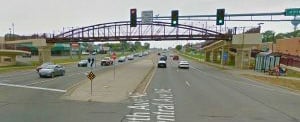
Large roads are great for moving vehicles through an area. However, if you are a pedestrian, getting across a wide, busy, high speed road can be daunting. No one wants to play Frogger in real time with real consequences. Except for maybe George Costanza. It is for this reason that pedestrian bridges are sometimes built. Pedestrian bridges allow for pedestrians and bicyclists to safely cross a busy road without conflicts.
But are pedestrian bridges worth building? It is not a cheap investment. Pedestrian bridges can cost several million dollars, or more. For some locations, such as across a freeway or a river, pedestrians and bicyclists need to cross at a bridge. But at a location where there is a more direct at-grade crossing, a pedestrian bridge may not be as beneficial as it would elsewhere.
One significant barrier to the use of a pedestrian bridge is the distance added to the pedestrian/bicyclist’s route. Because of the need to get up above cars and trucks (about 20 feet above the road), straight or spiral ramps are typically used that can be several hundred feet long depending upon the surrounding terrain. Therefore, an important question to ask is which is more valuable to the average pedestrian/bicyclist – a safe crossing using the pedestrian bridge or the time-savings of crossing the road at grade?
Recently, Traffic Data Inc. (TDI) helped Kimley-Horn and Associates determine the answer to this question at one location in Columbia Heights, Minnesota. This location had a pedestrian bridge over a busy four-lane divided road with turn lanes. At this signalized intersection, the major road travels north-south and the pedestrian bridge provides for east-west travel on the south side. There are no marked east-west crosswalks across the major road. Other characteristics of the intersection:
- The distance from curb to curb is about 140 feet
- The pedestrian bridge adds about 700 feet to the crossing distance
- The major road has about 25,500 vehicles per day
Using two video cameras, one camera pointed at the pedestrian bridge access on one side of the road and the other camera focused on the intersection, we conducted a 24-hour count of how pedestrians and bicyclists cross this major road.
From this 24 hours of data collection, approximately 44% of the 170 total pedestrians and bicyclists crossed using the pedestrian bridge. That means the majority picked convenience over safety in this case.
This result was not overly surprising to us. Most people tend to view the extra distance as a burden that will cause too much delay to them. With the signal providing some gaps in the traffic flow, no physical barriers to prevent the at-grade crossing, and a wide median to allow some pedestrians to cross only half of the road at a time, the safety risk may seem small to a lot of pedestrians. Personally, I’m unlikely to use a pedestrian bridge if I am on foot and there is a shorter option to cross the road, but I will generally use them on my bicycle to avoid having to stop.
For this location, and other locations considering pedestrian bridges, the two ways to increase its use are either making the bridge more convenient or making the at-grade crossing less convenient. Bloomington, Minnesota has a great example of making the bridge more convenient where the land is built up around the road and the natural path of the trail leads pedestrians up to the bridge. Discouraging the at-grade crossing typically involves plantings, fences, and redirecting the trail to make getting to the road and across it more difficult.

